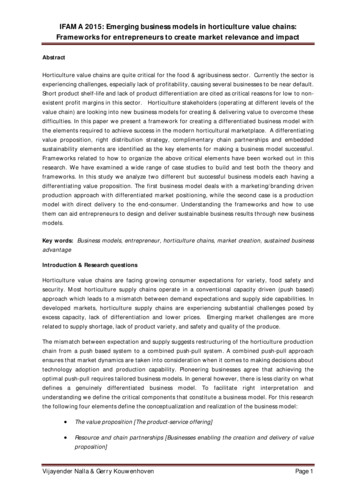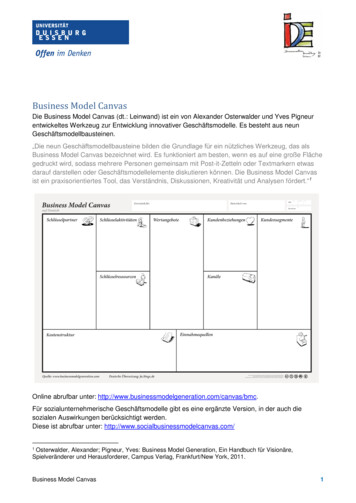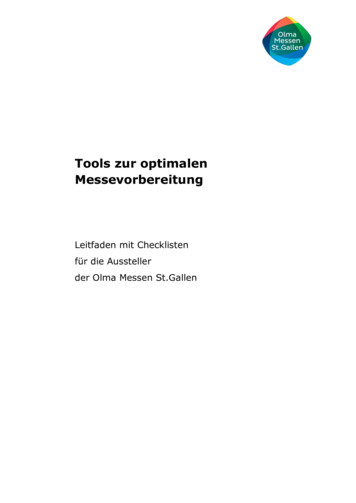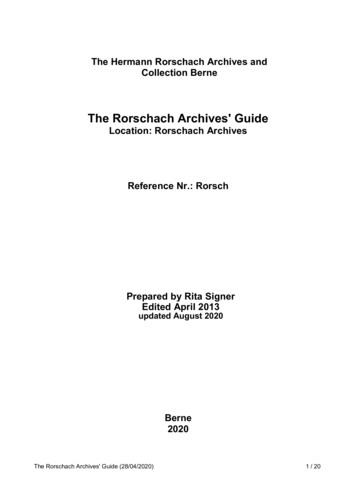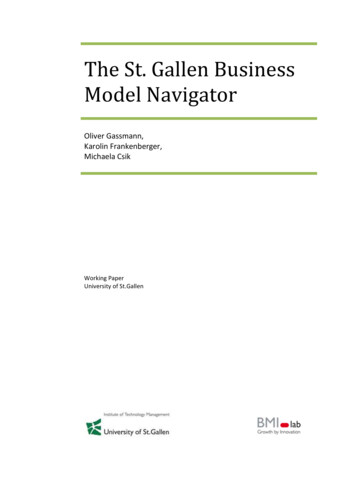
Transcription
The St. Gallen BusinessModel NavigatorOliver Gassmann,Karolin Frankenberger,Michaela CsikWorking PaperUniversity of St.Gallen
St. Gallen Business Model Navigator – www.bmi-lab.ch1The St. Gallen Business Model NavigatorTM1.New Products are not enoughThere are many companies with excellent technological products. Especially in Europe, manyfirms continuously introduce innovations to theirproducts and processes. Yet, many companies willnot survive in the long term despite their productinnovation capabilities. Why do prominent firms,which have been known for their innovative products for years, suddenly lose their competitive advantage? Strong players such as AEG, Grundig,Nixdorf Computers, Triumph, Brockhaus, Agfa,Kodak, Quelle, Otto, and Schlecker are vanishingfrom the business landscape one after the other.They have lost their capabilities of marketing theirformer innovative strengths. The answer is simpleand painful: these companies have failed to adapttheir business models to the changing environment.In future, competition will take place between business models, and not just between products andtechnologies.New business models are often based on earlyweak signals: Trendsetters signal new customerrequirements; regulations are discussed broadlybefore they are eventually approved. New entrantsto the industry discuss new alliances at great length;disruptive technology developments are results ofmany years of research. The insolvency of Kodak in2012 has also a long history. The first patents fordigital cameras had already been published by Texas Instruments in 1972. Kodak realized the potentialof the new technology and in the 90s initiated analliance on digital imaging with Microsoft in orderto conquer this new field. But – as can be observedfrequently – the disruptive move was faint-hearted.When the first digital cameras entered the market in1999, Kodak forecasted that ten years later digitalcameras would account for only 5 % of the market,with analog cameras remaining strong at 95 %. In2009, the reality was different: Only 5 % of themarket remained analog. This misjudgment was sograve and powerful that it was too late when Kodakphysically blew up its chemical R&D center inRochester in order to change the corporatedominant logic of analog imaging. Between 1988and 2008, Kodak reduced the number of its employees by more than 80 %, in 2012 Kodak filed forbankruptcy protection.It is often said that existing business models‘don’t work anymore’. Still, the typical answersprovided by R&D engineers are new productsbased on new technologies and more functionality.By contrast, the underlying business logic is rarelyaddressed despite the fact that business model innovators have been found to be more profitable byan average of 6 % compared to pure product orprocess innovators (BCG 2008). As a consequence,managers consider business model innovation to bemore important for achieving competitive advantage than product or service innovation, andover 90 % of the CEOs surveyed in a study by IBM(2012) plan to innovate their company’s businessmodel over the next three years. But a plan is notenough.When it comes to making the phenomenon tangible, people struggle. Very few managers are ableto explain their company’s business model ad-hoc,and even fewer can define what a business modelactually is in general. The number of companies,which have established dedicated business modelinnovation units and processes is even lower. Giventhe importance of the topic, this lack of corporateinstitutionalization is surprising – however, considering the complexity and fuzziness of the topic, it isto be expected.Before discussing how to innovate a businessmodel, it is important to understand what it is that isto be innovated. Historically, the business modelhas its roots in the late 1990s when it emerged as abuzzword in the popular press. Ever since, it hasraised significant attention from both practitionersand scholars and nowadays forms a distinct featurein multiple research streams. In general, the business model can be defined as a unit of analysis todescribe how the business of a firm works. Morespecifically, the business model is often depicted asan overarching concept that takes notice of thedifferent components a business is constituted ofand puts them together as a whole (Demil andLecocq 2010; Osterwalder and Pigneur, 2010). Inother words, business models describe how themagic of a business works based on its individualbits and pieces.Business model literature has not yet reached acommon opinion as to which components exactlymake up a business model. To describe the businessmodels throughout our study, we employ a conceptualization that consists of four central dimensions:the Who, the What, the How, and the Value. Due tothe reduction to four dimensions the concept is easyto use, but, at the same time, exhaustive enough toprovide a clear picture of the business model architecture.
St. Gallen Business Model Navigator – www.bmi-lab.chWho: Every business model serves a certaincustomer group (Chesbrough and Rosenbloom2002; Hamel 2000). Thus, it should answer thequestion Who is the customer? (Magretta 2002).Drawing on the argument from Morris et al. (2005,p. 730) that the failure to adequately define themarket is a key factor associated with venture failure , we identify the definition of the target customer as one central dimension in designing a newbusiness model.What: The second dimension describes what isoffered to the target customer, or, put differently,what the customer values. This notion is commonlyreferred to as the customer value proposition (Johnson et al. 2008), or, more simply, the value proposition (Teece 2010). It can be defined as a holisticview of a company's bundle of products and services that are of value to the customer (Osterwalder2004).How: To build and distribute the value proposition, a firm has to master several processes andactivities. These processes and activities, along withthe involved resources (Hedman and Kalling 2003)and capabilities (Morris et al. 2005), plus theirorchestration in the focal firm’s internal value chainform the third dimension within the design of a newbusiness model.Value: The fourth dimension explains why thebusiness model is financially viable, thus it relatesto the revenue model. In essence, it unifies aspectssuch as, for example, the cost structure and theapplied revenue mechanisms, and points to theelementary question of any firm, namely how tomake money in the business (see Fehler! Verweis-quelle konnte nicht gefunden werden.).Fig. 1 Business model definition – the magic triangleBy answering the four associated questions andexplicating (1) the target customer, (2) the valueproposition towards the customer, (3) the valuechain behind the creation of this value, and (4) therevenue model that captures the value, the businessmodel of a company becomes tangible and a common ground for its re-thinking is achieved. A central virtue of the business model is that it allows for2a holistic picture of the business by combiningfactors located inside and outside the firm (Teece2010; Zott et al. 2011). For this reason, it is oftenreferred to as a boundary-spanning concept thatexplains how the focal firm is embedded in, andinteracts with, its surrounding ecosystem (Shafer etal. 2005; Zott and Amit 2008). The task most commonly attributed to the business model is that ofexplaining how the focal firm creates and capturesvalue for itself and its various stakeholders withinthis ecosystem.Considering the vast scope that is subsumed under the business model umbrella, it becomes clearthat, in the real world, a firm’s business model is acomplex system full of interdependencies and sideeffects. Changing – or innovating – the businessmodel can hence be assumed to be a major undertaking that can quickly become very challenging.Generations of managers have been trained within Porter’s five forces of industry analysis. MichaelPorter taught us to analyze the industry and try togain comparative competitive advantage due tobetter positioning. Kim and Mauborgne (2005)paved the way out of Porter’s box. ‘Beat your competitor without trying to beat your competitor’ is thecredo that obliges companies to leave their highlycompetitive own industry and create new uncontested markets in which they can prosper. It is amantra for business innovators as we have seen inour own research and coaching of companies during the last decade. IKEA revolutionized the furniture business, Apple successfully re-defined industry boundaries, and Zara reinvented the Europeanfashion industry with high-speed cycles. Manyothers revolutionized their industries in a very radical way: Mobility car sharing, Car2go, TomTom,Wikipedia, Microinsurance, Better Place, Verizon,and Bombardier Flexjet are only a few examples ofcompanies which escaped the traditional industrylogic and therefore redefined their respective industries.So, why do not more companies just come upwith a new business model and move into a ‘blueocean’? It is because thinking outside the box ishard to do – mental barriers block the road towardsinnovative ideas. Managers struggle to turn aroundthe predominant logic of ‘their’ industry, whichthey have spent their entire careers understanding.First, many managers do not see why they shouldleave the comfort zone as long as they are still making profits. Second, it is common knowledge thatthe harder you try to get away from something, thecloser you get to it. Bringing in outside ideas mightseem promising in this case – however, the notinvented here (NIH) syndrome is well known andwill soon quash any outside idea before it can takeoff in a company.In view of these barriers, a successful approachthat leads to innovative business model ideas must
St. Gallen Business Model Navigator – www.bmi-lab.chmaster the balancing act of bringing in stimuli external to an industry to achieve novelty while, at thesame time, enabling those within an industry todevelop their own innovative business model ideas.Research methodologyAs business innovation research is still a youngphenomenon, we used a two-step approach to analyze the basic patterns of business models.In phase 1 we analyzed 250 business models thathad been applied in different industries within thelast 25 years. As a result we identified 55 patternsof business models which served as the base fornew business models in the past. More than fiveyears of research and practice in the area of business model innovation have culminated in a methodology that helps firms structure and navigate theprocess: the Business Model Innovation Map,which guides the innovator through the many opportunities a company faces (see also Gassmann etal. 2013).In phase 2 we used that knowledge and, togetherwith selected companies, developed a constructionmethodology which is based on two basic principles: First, 90 % of all new business models haverecombined already existing ideas, concepts andtechnologies as we found in our research group.Consequently this fact has to be used for developing new business models. Second, we applied theiterative process of design thinking, which wasdeveloped at the Institute of Design at StanfordUniversity. This action-based research approachhelped us to learn more about the practical use ofthe design of new business models.We applied the methodology with teams in thefollowing companies: BASF (chemicals), Bühler(machinery), Hilti (construction tools), Holcim(cement), Landis&Gyr (electricity metering), MTU(turbines), SAP (software), Sennheiser (audio technology), Siemens (health care), Swisscom (telecom).In all companies, investments have been initiated asa result of the business model project, in somecompanies up to double-digit million amounts areinvested. In addition we used the approach duringthree years of teaching Executive MBA students atthe Executive School in St. Gallen and applied it ina one-day workshop for more than 50 companies.3This experience has been built into the methodology as well.2.Creative Imitation and the Powerof RecombinationThe phrase There’s no need to reinvent thewheel describes the fact that, at a closer look, onlyfew phenomena are really new. Often, innovationsare slight variations of something that has existedelsewhere, in other industries, or in other geographical areas. We have looked at several hundred business model innovators and were not surprised tofind that about 90 % of the innovations turned outto be such re-combinations of previously existingconcepts. We identified 55 repetitive patterns thatform the core of many new business models (seeGassmann et al. 2012; Gassmann et al. 2013). Thebusiness model innovation map (see Figure 2) depicts the 20 most popular patterns as lines, alongwith the companies which applied them in theirnew business models.The RAZOR AND BLADE pattern, for example,goes back to Gillette’s 1904 move to give the baseproduct (the razor) away for a low price and earnmoney through higher-priced consumables (theblades). The pattern, which defines the value proposition and revenue logic of a business model, hasspread across many industries since then. Examplesinclude inkjet printers and cartridges, blood glucosemeters and test stripes, or Nespresso’s coffee machines and capsules. In the world of business models, there is really not much that is actually new –but many powerful adaptations and applicationscontexts and industries can be found.What can we learn from this observation? Clearly, the patterns of business models identified canserve as an inspiration when innovations of business models are considered. If they could be adopted elsewhere, why not apply them to one’s owncompany? This approach brings in external stimuliwhile, at the same time, allowing enough room toprevent the NIH syndrome. Over time, we havedeveloped the 55 business model patterns identifiedinto the central ideation tool of our St. Gallen Business Model NavigatorTM methodology.
St. Gallen Business Model Navigator – www.bmi-lab.chFig. 2 The business model innovation map: Every node represents a revolution of an industry.4
St. Gallen Business Model Navigator – www.bmi-lab.chThe St. Gallen Business Model NavigatorTMtransforms the main concept – creating businessmodel ideas by utilizing the power of recombination – into a ready-to-use methodology,which has proven its usefulness in countless workshops and other formats. Three steps pave the roadto a new business model:Step 1: Initiation – preparing the journeyBefore embarking on the journey towards newbusiness models, it is important to define a startingpoint and rough direction. Describing the currentbusiness model, its value logic, and its interactionswith the outside world is a good exercise to get intothe logic of business model thinking. It also builds acommon understanding of why the current businessmodel will need an overhaul, which factors endanger its future, or which opportunities cannot beexploited due to the current way of doing business.Explicating these woes and the predominant industry logic provides a rough direction according towhich the generic business model patterns shouldbe interpreted in step 2.Success factors: Involve open-minded team members fromdifferent functions; the involvement of industryoutsiders supports thinking outside the box.Overcome the dominant industry logic: Forbidden are sentences like ‘this has alwaysworked like that in our industry’. Instead, a funeral speech for one s own business helps toovercome the past. Why did the company die?This is a fascinating exercise, which McKinseyhas often used successfully in change projectswhen individuals needed to overcome mentalbarriers.Use methodological support, e.g., card sets,business model innovation software (seewww.bmi-lab.ch for our methodological approach and background information).Step 2: Ideation – moving into new directions6needed to understand the concept behind the pattern: a title, a description of the general logic, and aconcrete example of a company implementing thepattern in its business model. During the stage ofideation, the level of information on the card is justright to trigger the creation of innovative ideas.The way in which we apply the cards is termedpattern confrontation to describe the process ofadapting the pattern to one’s own initial situation.Participants, typically divided into groups of threeto five people, ask themselves how the patternwould change their business model if applied totheir particular situation.At first glance the cards might seem unrelated tothe problem, however, the results are quite surprising. Often the stimuli, in the form of pattern cards,cause innovative ideas to emerge, which inspirediscussions among the group members. In one instance, for example, the task of fitting the SUBSCRIPTION pattern to the business model of a machine manufacturer led to the idea of trainingsought-after plant operators and leasing them tocustomers. The concept was implemented and nowcontributes to the company’s turnover while at thesame time strengthening ties with customers –which had been the original reason for thinkingabout a new business model.Success factors: Try not only the close patterns, but also confront more distant patterns. We had very surprising results when a 1st tier automotive supplier applied the question: ‘How wouldMcDonald s conduct your business?’. For example, McDonald’s front desk employees arefully productive after a 30-minute introduction.The automotive supplier had to learn that reducing complexity would lead to totally newbusiness models and would also stimulatequick learning.Keep on trying. At first, it seems impossible tolearn something from industry outsiders. Especially individuals with a profound backgroundin the existing industry have difficulties inovercoming the dominant industry logic.Step 3: Integration – completing the pictureRe-combining existingconcepts is a powerful toolto break out of the box andgenerate ideas for newbusiness models. To easethis process, we have condensed the 55 patterns ofsuccessful business modelsFig. 3 Pattern card setinto a handy set of patterncards. Each pattern card (seeFigure 3) contains the essential information that isThere is no idea that is clear enough to be immediately implemented in a company. On the contrary,promising ideas need to be gradually elaboratedinto full-blown business models that describe allfour dimensions - Who-What-How-Value? - andalso consider stakeholders, new partners, and consequences for the market. A set of checklists andtools, such as the value network methodology, areavailable in the St. Gallen Business Model Naviga-
St. Gallen Business Model Navigator – www.bmi-lab.chtorTM to ease the process of quickly elaborating andexplicating the business model around a promisingidea. The list of example companies on each patterncard makes it possible to draw inspiration fromother companies which implemented the same pattern.Success factors: 3.Be consistent. Consistency between the internaland the external world is necessary. There hasto be a fit between the internal core competencies, the competitor’s perspective, and the perceived customer value.Try hard. Developing a business model andimplementing the idea in one s own companyrequires a lot of work.ConclusionsWith the St. Gallen Business Model NavigatorTMa new methodology has been developed that structures the process of innovation of a company’sbusiness model and encourages outside-the-boxthinking, which is a key prerequisite for successfulbusiness models. Well-grounded in theory, it hasproven its applicability in practical settings manytimes over.In order to achieve successful business modelinnovations within a company it is important to notonly acknowledge the importance of business model innovation, but to implement an effective business model innovation process within the firm. Thisis the most difficult, but also the most importantstep. Various tools have been developed to supportmanagers during the business model innovationprocess1:Given the overwhelming demand for a newbusiness model innovation methodology, the journey of the St. Gallen Business Model NavigatorTMwill continue. The future race for comparativecompetitive advantages has shifted from pure products and services to business models. Firms need toget ready for that race. Identifying the opportunityis not enough, innovators and entrepreneurs have tocapture the opportunity and start moving. Knowingthe past helps in creating the future.7Business model innovationsoftwareInteractive software allows users to explore the55 business model patterns and the map interactively. The software supports the construction of anew business model basedon the St. Gallen BusinessModel NavigatorTMthroughout the companyon a worldwide scale.Online learningThe online learning courseis aimed at employees andin an interactive way explains the logic and importance of business model innovation and thepower of recombining existing business model elements.55 business model cardsThe set of 55 businessmodel cards supports thecreative ideation processduring workshops.www.bmi-lab.ch.The following managerial implications shouldprove valuable for practitioners using this newapproach to revolutionize their business model:1. Challenge the dominant logic by using confrontation techniques. The 55 patterns of businessmodels identified support this challenging task.2. Use an iterative approach with many loops.3. Use haptic cards or other devices to stimulate thecreative thinking process.4. Carefully decide when to change between divergent and convergent thinking, the managementof the balance between creativity and disciplinerequires some experience.5. Create a culture of openness: there are no holycows in the room.
4.NoThe 55 business model patternsPatternnameAffectedBMcomponentsExemplary companiesPattern descriptionThe core offering is priced competitively, but there arenumerous extras that drive the final price up. In the end, thecostumer pays more than he or she initially assumed. Customers benefit from a variable offer, which they can adaptto their specific needs.The focus lies in supporting others to successfully sellproducts and directly benefit from successful transactions.Affiliates usually profit from some kind of pay-per-sale orpay-per-display compensation. The company, on the otherhand, is able to gain access to a more diverse potentialcustomer base without additional active sales or marketingefforts.Aikido is a Japanese martial art in which the strength of anattacker is used against him or her. As a business model,Aikido allows a company to offer something diametricallyopposed to the image and mindset of the competition. Thisnew value proposition attracts customers who prefer ideasor concepts opposed to the mainstream.Auctioning means selling a product or service to the highest bidder. The final price is achieved when a particular endtime of the auction is reached or when no higher offers arereceived. This allows the company to sell at the highestprice acceptable to the customer. The customer benefitsfrom the opportunity to influence the price of a product.Barter is a method of exchange in which goods are givenaway to customers without the transaction of actual money.In return, they provide something of value to the sponsoring organisation. The exchange does not have to show anydirect connection and is valued differently by each party.1ADD-ONWhatValueRyanair (1985), SAP(1992), Sega (1998)2AFFILIATIONHowValueAmazon Store (1995),Cybererotica (1994),CDnow (1994), Pinterest(2010)3AIKIDOWhoWhatValueSix Flags (1961), TheBody Shop (1976),Swatch (1983), Cirque duSoleil (1984), Nintendo(2006)4AUCTIONWhatValueeBay (1995), Winebid(1996), Priceline (1997),Google (1998), Elance(2006), Zopa (2005),MyHammer (2005)5BARTERWhatValueProcter & Gamble (1970),Pepsi (1972), Lufthansa(1993), Magnolia Hotels(2007), Pay with a Tweet(2010)6CASH MA-HowValueAmerican Express (1891),Dell (1984), AmazonStore (1995), PayPal(1998), Blacksocks(1999), MyFab (2008),Groupon (2008)Shell (1930),IKEA(1956), Tchibo(1973), Aldi (1986),SANIFAIR eFUNDINGMarillion (1997), CassavaFilms (1998), Diaspora(2010), Brainpool (2011),Pebble Technology(2012)In the Cash Machine concept, the customer pays upfront forthe products sold to the customer before the company isable to cover the associated expenses. This results in increased liquidity which can be used to amortise debt or tofund investments in other areas.In this model, services or products from a formerly excluded industry are added to the offerings, thus leveragingexisting key skills and resources. In retail especially, companies can easily provide additional products and offeringsthat are not linked to the main industry on which they werepreviously focused. Thus, additional revenue can be generated with relatively few changes to the existing infrastructure and assets, since more potential customer needs aremet.A product, project or entire start-up is financed by a crowdof investors who wish to support the underlying idea, typically via the Internet. If the critical mass is achieved, theidea will be realized and investors receive special benefits,usually proportionate to the amount of money they provided.
St. Gallen Business Model Navigator – tsExemplary companiesPattern descriptionSOURCINGHowValueThreadless (2000),Procter & Gamble (2001),InnoCentive (2001),Cisco (2007), MyFab(2008)CUSTOMERLOYALTYWhatValueSperry & Hutchinson(1897), American Airlines(1981), Safeway ClubCard (1995), Payback(2000)DIGITIZA-WhatHowSpiegel Online (1994),WXYC (1994), Hotmail(1996), Jones International University (1996),CEWE Color (1997),SurveyMonkey (1998),Napster (1999), Wikipedia (2001), Facebook(2004), Dropbox (2007),Netflix (2008), Next IssueMedia (2011)Vorwerk (1930), Tupperware (1946), Amway(1959), The Body Shop(1976), Dell (1984),Nestle Nespresso (1986),First Direct (1989), NestléSpecial.T (2010), DollarShave Club (2012), NestléBabyNes (2012)The solution of a task or problem is adopted by an anonymous crowd, typically via the Internet. Contributors receivea small reward or have the chance to win a prize if theirsolution is chosen for production or sale. Customer interaction and inclusion can foster a positive relationship with acompany, and subsequently increase sales and revenue.Customers are retained and loyalty assured by providingvalue beyond the actual product or service itself, i.e.,through incentive-based programs. The goal is to increaseloyalty by creating an emotional connection or simplyrewarding it with special offers. Customers are voluntarilybound to the company, which protects future revenue.This pattern relies on the ability to turn existing products orservices into digital variants, and thus offer advantagesover tangible products, e.g., easier and faster distribution.Ideally, the digitization of a product or service is realizedwithout harnessing the value proposition which is offeredto the customer. In other words: efficiency and multiplication by means of digitization does not reduce the perceivedcustomer WhatHowValueEXPERIENCESELLINGWhatWhoValue15FLAT alueDell (1984), Asos (2000),Zappos (1999), AmazonStore (1995), Flyeralarm(2002), Blacksocks(1999), Dollar Shave Club(2012), Winebid (1996),Zopa (2005)Harley Davidson (1903),IKEA (1956), TraderJoe's (1958), Starbucks(1971), Swatch (1983),Nestlé Nespresso (1986),Red Bull (1987), Barnes& Noble (1993), NestléSpecial.T (2010)SBB (1898), BuckarooBuffet (1946), SandalsResorts (1981), Netflix(1999), Next Issue Media(2011)Hapimag (1963), Netjets(1964), Mobility Carsharing (1997), écurie25(2005), HomeBuy (2009)Direct selling refers to a scenario whereby a company'sproducts are not sold through intermediary channels, butare available directly from the manufacturer or serviceprovider. In this way, the company skips the retail marginor any additional costs associated with the intermediates.These savings can be forwarded to the customer and astandardized sales experience established. Additionally,such close contact can improve customer relationships.Traditional products or services are delivered throughonline channels only, thus removing costs associated withrunning a physical branch infrastructure.Customers benefit from higher availability and convenience, while the company is able to integrate its sales anddistribution with other internal processes.The value of a product or service is increased with thecustomer experience offered with it. This opens the doorfor higher customer demand and commensurate increase inprices charged. This means that the customer experiencemust be adapted accordingly, e.g., by attuning promotion orshop fittings.In this model, a single fixed fee for a product or service ischarged, regardless of actual usage or time restrictions onit. The user benefits from a simple cost structure while thecompany benefits from a constant revenue stream.Fractional ownership describes the sharing of a certainasset class amongst a group of owners. Typically, the assetis capital intensive but only required on an occasional basis.While the customer benefits from the rights as an owner,the entire capital does not have to be provided alone.
St. Gallen Business Model Navigator – nentsExemplary companiesPattern descriptionCHISINGWhatHowValueThe franchisor owns the brand name, products, and corporate identity, and these are licensed to independent franchisees who carry the risk of local operations. Revenue isgenerated as part of the franchisees’ revenue and orders.The franchisees benefit from the usage of well knownbrands, know-how, and support.FREEMIUMWhatValueSinger Sewing Machine(1860), McDonald's(1948), Marriott Inter
in Porter's five forces of industry analysis. Michael Porter taught us to analyze the industry and try to gain comparative competitive advantage due to better positioning. Kim and Mauborgne (2005) paved the way out of Porter's box. 'Beat your com-petitor without trying to beat your competitor' is the



